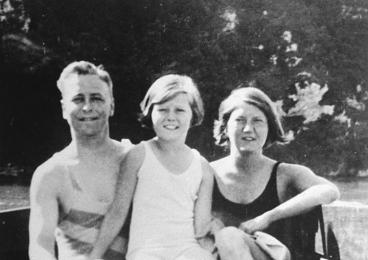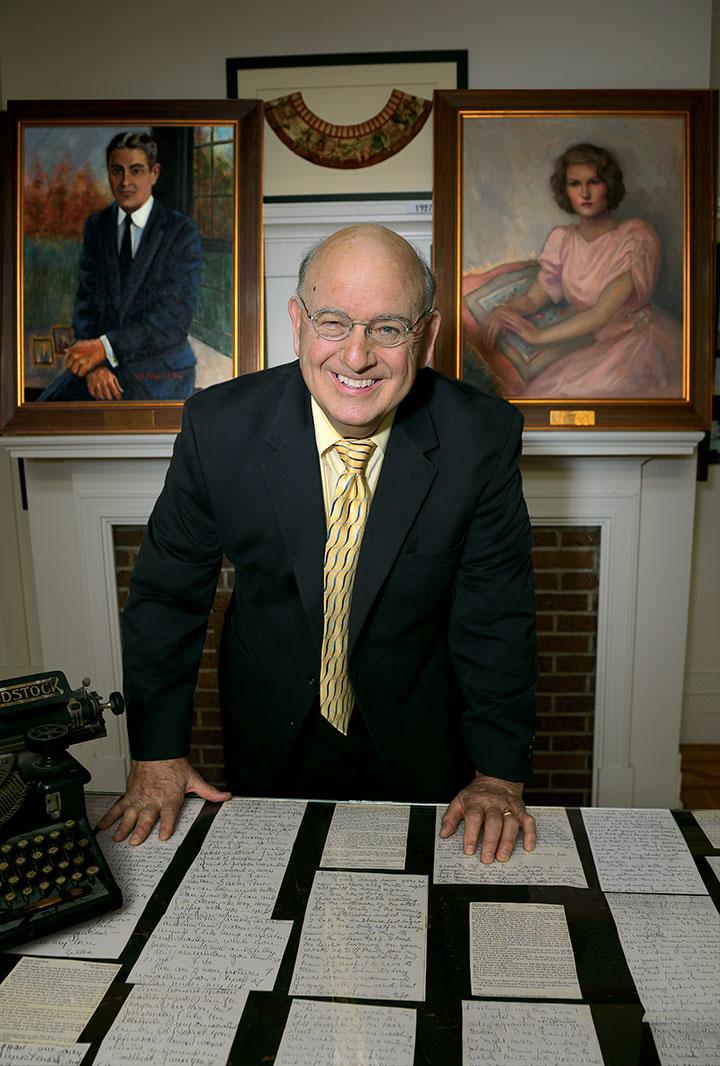It was not literary obsession that drove Julian McPhillips ’68 to create a museum honoring the most spellbinding couple of the Jazz Age. Yes, McPhillips had a fondness for F. Scott Fitzgerald 1917, whose novels he read in high school. And yes, like Scott’s famous wife, Zelda, McPhillips had deep Alabama roots, going back to antebellum days.
But it wasn’t until the mid-1980s that his casual interest turned into a passion. By then, McPhillips was a lawyer living in the historic Old Cloverdale neighborhood of Montgomery, Ala. Down the street, at 919 Felder Ave., was the home rented and occupied for seven months in 1931–32 by the Fitzgeralds. This was the place where Zelda began her first and only novel — for some biographers, a profound act of emancipation by a woman with a public high school diploma against her overbearing Ivy League husband. But the house, which had been divided and converted into a boarding house in the late 1930s, was being targeted by developers.
Concerned that Cloverdale’s stately homes amid trees draped in Spanish moss soon would be transformed into townhouses, McPhillips and his wife, Leslie, purchased the dilapidated property for $100,000 in 1986, refurbished it, and opened it in 1989 as the Scott & Zelda Fitzgerald Museum. “My motives were not 100 percent altruistic,” McPhillips acknowledges.
Stepping inside the brick-and-brown-clapboard, Craftsman-style house — which the McPhillipses have donated to a nonprofit association — a visitor today is plunged into the world of the Fitzgeralds. Walls are lined with artifacts and pictures that tell the story of how Scott rode the skyrocket of fame with his debut Princeton novel This Side of Paradise, in 1920, and faced a lackluster response to The Great Gatsby five years later. Zelda, the headstrong daughter of a prominent Montgomery judge, became a media darling as the iconic flapper, epitome of the liberated young woman of that freewheeling age.

Scott and Zelda, who just had been released from treatment for schizophrenia at a sanitarium in Switzerland, returned in 1931 to Montgomery, where they had met when he was in the Army. Today the house they rented is “the only museum devoted to them both,” McPhillips says with pride. “It tells the story of a married couple, both of whom were iconic and renowned.” Displays show photographs and publications associated with the Fitzgeralds at various stages of their lives, including a case filled with Princeton memorabilia such as Scott’s contributions to the Nassau Lit and posters of his Triangle shows. A back bedroom houses Zelda’s paintings. Period furniture gradually is being added to complete the scene. It has taken McPhillips — who is best known for his work both as a civil-rights lawyer and as an anti-abortion activist — decades to restore the rambling old home with its spacious rooms and wood-inlay floors. The impression is of quiet comfort in these inviting, sunlit rooms that look out to a wide green lawn and magnolia trees, a mood at variance with the turmoil that wracked the Fitzgeralds here.
Living at the house, the Fitzgeralds plunged from hopefulness to deep gloom — Scott later would look back on “all the horrors in Montgomery.” Gallons of gin, violent rows, and illicit love affairs — Scott’s with a Hollywood actress and Zelda’s with a French aviator — had threatened their marriage even before they arrived in Alabama. They reached Montgomery with their daughter, known as Scottie, in September, seeking a refuge. Zelda was fond of her parents, who lived near Old Cloverdale. Scott felt the quiet would settle Zelda’s shattered nerves; meanwhile, he could turn his full attention to writing. “He must have thought Zelda showed signs of being able to recover,” says biographer Scott Donaldson, who has helped advise the museum, “and their marriage could be a real one again.”
For the Fitzgeralds, the Montgomery home offered much-needed balm — and curator Willie Thompson paints a picture of them entertaining in the great room, writing in the study, relaxing in the sunporch. But then Scott abruptly announced he was leaving for Hollywood to earn some money from movie scripts. He vanished for weeks to the place where he had taken a lover four years earlier. With Scott gone, the unhappy Zelda began to write intensively.

One of the most fascinating photographs on display in the museum shows Zelda, wearing dancer’s garb, seated on her travel trunks in the sunporch of this very house. (The windows and artist-tile floor remain unchanged.) This publicity photo for the fledgling writer was meant to flaunt her public persona: the insouciant young disciple of ballet, ready to sail to Hemingway’s Paris in a heartbeat.
When Scott came home from California — the sunporch now occupied by a Christmas tree — his wife pointed with pride to her new story in Scribner’s Magazine and a novel underway. Soon, however, the atmosphere in the house grew poisonous. Zelda wrote relentlessly, wreathed in cigarette smoke, and angrily accused Scott of causing her eyestrain. Fights became constant. Scott believed she must return to the hospital. Together, the Fitzgeralds drove to the Montgomery train station in dreary February 1932, headed for the Phipps Clinic in Baltimore.
Meanwhile, Scott returned to the Montgomery house, so that Scottie could finish the school year. He anguished over the hospital bills that would further postpone his novel-writing and explored a possible divorce. While Zelda’s friends and family muttered that Scott had destroyed her life, he told his confidants that everything was Zelda’s fault: She had been the promiscuous “town scandal” before he ever met her; she corrupted him; she introduced him to drinking; in France she shamelessly fell in love with men and women alike.
Into this emotional maelstrom fell the manuscript of Zelda’s novel, Save Me the Waltz, which she somehow completed in the clinic wards March 9. Five days later, Scott read it in the Montgomery house. When he saw that her novel drew on the same themes he was writing about himself, his anger proved volcanic.
Now he became unhinged: Zelda, he wrote in fury to her physician, had produced “an imitation” of his own unfinished novel, the very book he so desperately needed to complete but could not because he was paying for her treatment. Zelda, he was certain, was trying to destroy him — she even had named an unattractive character Amory Blaine, the Princeton-undergraduate protagonist in his autobiographical This Side of Paradise. How dare she “build this dubitable career of hers with morsels of living matter chipped out of my mind, my belly, my nervous system and my loins?” he fumed.
That awful spring of 1932 marked the beginning of the end for Scott and Zelda. Leaving the Montgomery house behind in April, Scott traveled to Baltimore, moving in with the family of Andrew Turnbull ’42, later his most sympathetic biographer. Zelda’s novel was published with some alterations demanded by Scott. His own novel, Tender Is the Night, appeared in 1934 but sold poorly. Despairing, he sometimes drank 30 cans of beer or a quart of gin a day, landing in hospital wards eight times between 1933 and 1937, and twice attempted suicide. Yet the couple never divorced.

Zelda turned from writing to painting, and the museum has 11 examples of her idiosyncratic artistic output, including flowers of oddly menacing aspect, a favorite theme. Especially popular with visitors are her colorful paper dolls, a genre she adored, crafting many for grandson Thomas Lanahan ’69, who would commit suicide as a young man. Some items on display hint at the relationship between Scott and other family members: There is a stamp book assembled by Scott and Scottie, begun in Paris, a product of their close relationship.
In 1936 Zelda left the Baltimore clinic for one in Asheville, N.C., and she was in and out of there for the rest of her life. Scott died in 1940; Zelda perished in a fire at the hospital eight years later.
This tale of wasted talent and doomed marriage is the story McPhillips’ museum helps tell today. About 3,500 visitors arrive annually; Scott would hardly be thrilled to know that most of those tourists come for Zelda, says Thompson — his “third-rate talent” of a wife (as Scott once called her) who lately has become the darling of biographers and inspiration for novels, plays, and even the title of a video game.
Today the house forms an important link in the Southern Literary Trail, along with sites dedicated to Ralph Ellison and Harper Lee, and sponsors an annual writing contest for high school and college students. When the museum hosted a Fitzgerald literary conference a few years ago, attendees came from as far away as Australia. All this makes McPhillips hope that the place will grow into a center of Scott and Zelda Fitzgerald scholarship or, perhaps, “we could have a literary colony there” — these are far-off dreams.
W. Barksdale Maynard ’88 has written about F. Scott Fitzgerald in Princeton: America’s Campus and The Brandywine: An Intimate Portrait. His grandmother grew up in Montgomery with Zelda.


